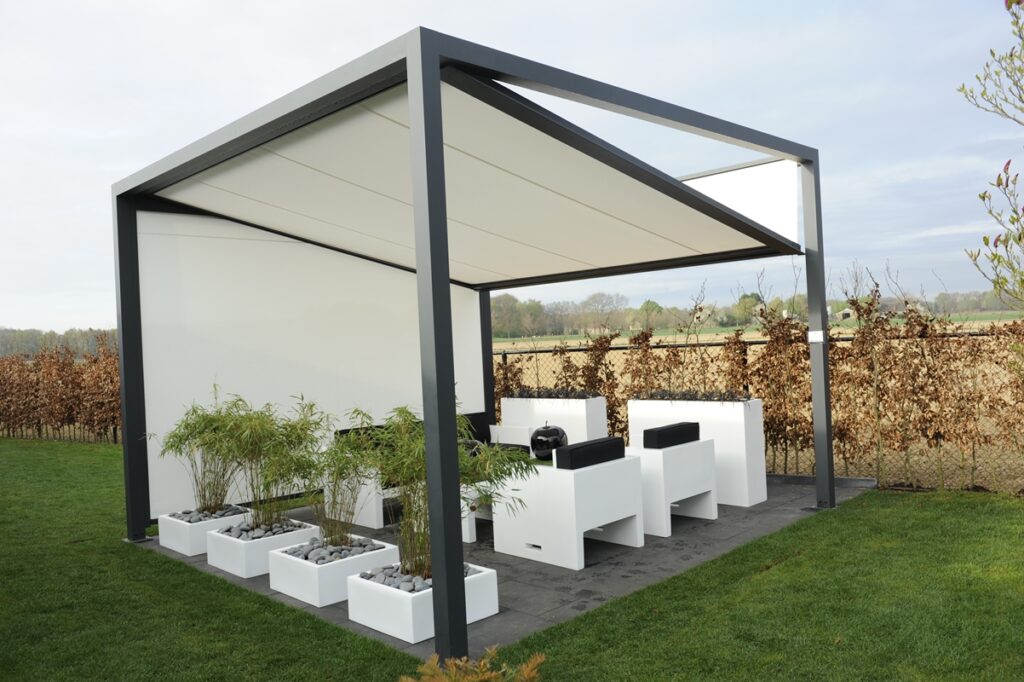Shelter and comfort can be found in a variety of ways, and one of the most stylish is with a pergola awning. While some may think that installing an awning is too expensive or time consuming, there are actually many benefits to having one.
When installed correctly, an awning can provide shade from the sun, protection from the wind as well as added privacy and style to any outdoor space. In this article we will explore the different types of pergola awnings available on the market today, their materials, design considerations and installation process.
We will also discuss maintenance requirements and costs associated with owning one so that you can make an informed decision about whether or not this type of shelter would be right for your home or business.
Benefits of Installing a Pergola Awning
@ Midjourney AI Image Prompt: /imagine prompt:A family sitting under a pergola awning in their backyard, enjoying the shade and protection from the elements. –v 5 –ar 3:2 (Note: Use –v 4 if you do not have a paid Midjourney account)
Installing a pergola awning can provide numerous advantages to homeowners. Among the most beneficial of these is weather protection. A well-designed and installed pergola awning can provide dependable shade from the sun, as well as shelter from rain and other inclement weather. This not only makes outdoor areas more comfortable for entertaining guests or having meals outdoors, but also helps protect furniture and other items that may be placed outside.
Temperature control is another benefit of installing a pergola awning. By providing shade and shelter from direct sunlight, an awning can help keep an outdoor area cooler on hot days by reducing direct exposure to the sun’s rays. This cooling effect can be further augmented with fans or misters that are attached directly to the structure of the pergola in order to create even greater comfort during summer months.
The aesthetic appeal of adding a pergola awning should not be underestimated either; many homeowners have found it to be an attractive addition to their outdoor living spaces that helps them create an inviting atmosphere for relaxation, entertainment, or family gatherings. The customizable nature of pergola awnings also means they can easily blend in with many different architectural styles while still providing all the practical benefits discussed above.
Finally, when installed correctly, pergolas offer substantial durability against harsh weather conditions such as wind and hail due to their sturdy construction materials and support beams which allow them to withstand severe storms better than typical patio covers or umbrellas. With this in mind, investing in one will give you peace of mind knowing it will give you years worth of reliable service while also making your home look great at the same time.
From these points alone it’s easy to see why so many people are choosing to install apergola awaning for both form and function at their home – something which offers shelter and comfort all year round! With this knowledge now available, it is now time for us explore what types of pergola awanings are available…
Types of Pergola Awnings
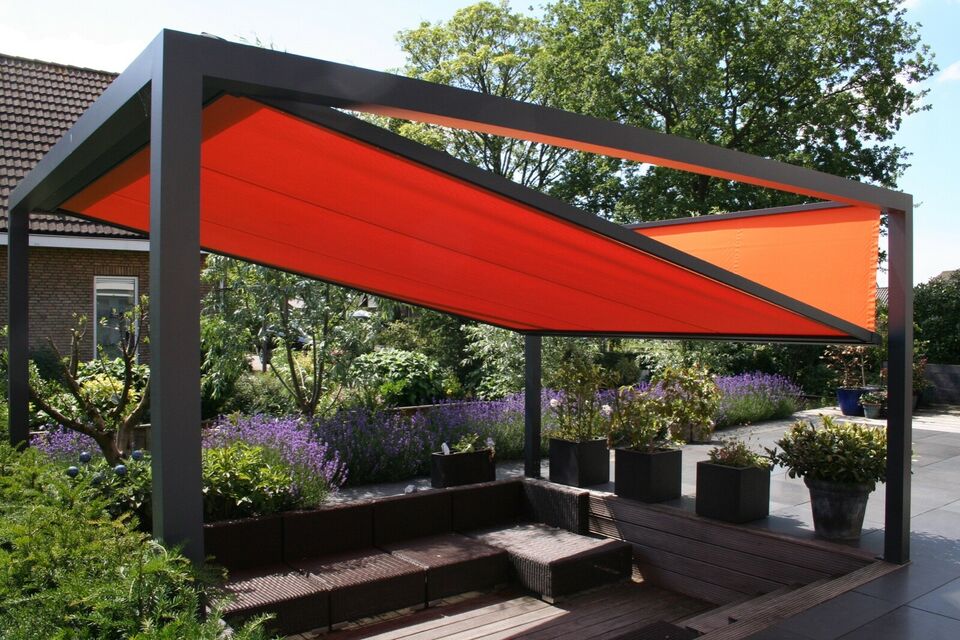
Constructing a pergola awning offers the opportunity to balance both practicality and aesthetics; after all, they say beauty is in the eye of the beholder. There are several types of pergola awnings available, depending on one’s individual needs:
- Retractable Awnings – These typically feature motorized mechanisms for easy deployment and can be retracted when not needed. They are ideal for providing maximum coverage from harsh sunlight or rain.
- Motorized Awnings – These are similar to retractable awnings but with more advanced technology allowing for greater control over how much sun and rain they block. They also tend to be more expensive than manual models.
- Manual Awnings – These require human labor to open and close them but are often cheaper than motorized varieties. They offer less coverage than their motorized counterparts but may still provide adequate protection against weather elements such as wind and rain.
No matter what type of pergola awning one chooses, these elegant structures can provide added comfort and shelter without sacrificing style or elegance. By carefully selecting the right materials, homeowners can ensure that their outdoor space looks great while providing effective protection from the elements year-round without breaking their budget.
With careful consideration given to each of these factors, it is possible to create an outdoor oasis that will last for years to come with minimal effort required on the part of the homeowner. From this point forward, understanding which materials best suit each application will help determine which type of pergola awning will best serve its purpose in terms of both form and function.
Materials for Pergola Awnings
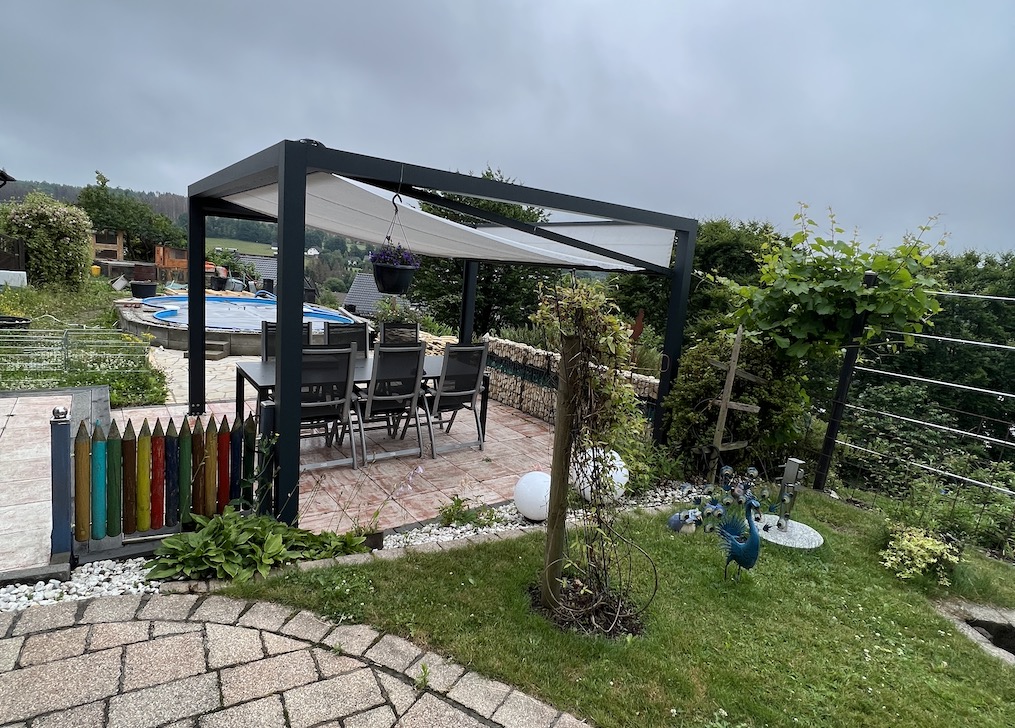
Creating an aesthetically pleasing outdoor environment while providing protection from the elements requires careful selection of appropriate materials for pergola awnings.
The two most popular materials used to construct these awnings are canvas fabric and metal frames.
Canvas fabric is lightweight, breathable, water-resistant, and cost-effective; making it one of the most popular material choices for homeowners seeking an economical option to shield their outdoor space.
Metal frames offer more durability than canvas fabric but come at a higher price tag due to their heavy weight and susceptibility to rust and corrosion over time.
When choosing between the two materials for a pergola awning, there are several factors that need to be taken into consideration.
These include the size of the space, budget constraints, desired aesthetic look, weather conditions in the area, and maintenance needs over time.
For instance, if you live in an area with high humidity or exposure to saltwater spray or have limited financial resources available then canvas may be your best option.
On the other hand if you live in an area with extreme temperatures or require more long-term durability then metal frames would likely be your preferred choice.
Other considerations should include how much sun or shade you wish to provide under your pergola as well as any additional features such as decorative trimming that can add visual interest to your space without compromising its structural integrity or stability over time.
Additionally, when selecting material for your pergola awning it’s important that you select something that is easy to clean and maintain since this will extend its lifespan significantly regardless of whether you choose canvas fabric or metal frames.
Design considerations for a pergola awning range from selecting complementary colors and patterns within existing décor schemes through to ensuring sufficient ventilation is provided along with proper drainage away from adjacent structures such as walkways or pool areas.
It’s important that all aspects of design are planned carefully prior to installation so that your new outdoor oasis provides years of enjoyment without requiring frequent maintenance down the track.
Design Considerations for a Pergola Awning
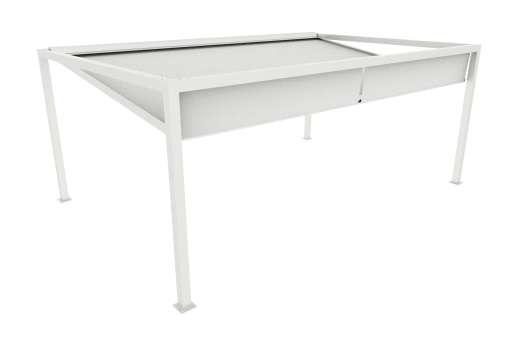
Crafting an aesthetically pleasing outdoor space with the necessary protection from the elements requires thoughtful consideration of design elements when selecting a pergola awning, akin to weaving a tapestry of style and practicality.
One must consider both size requirements and shade selection for their desired area. The size of the pergola should be considered in relation to the space available for installation; too small or large will create an imbalanced aesthetic. Additionally, one must decide on what type of material they want to use for their awning: canvas, aluminum, fabric, or polycarbonate are all viable options depending on location and weather conditions.
Furthermore, shade selection is important as it affects how much sunlight reaches the area beneath it. Too little shade can leave the area unbearably hot during summer months, while too much can make it feel dark and dismal even on sunny days. Therefore, careful consideration must be taken when choosing the right type of shade for each individual’s needs.
Creating an inviting atmosphere with a pergola awning also includes considering its decorative features such as lighting fixtures and curtains that could add style and character to any outdoor setting. Carefully chosen lights can create intimate ambiances in evening hours while curtains can soften hard lines in more contemporary designs.
Finally, one should think about whether they would like to have their pergola freestanding or attached to their home; this decision will depend largely on personal preference but should not be overlooked as both offer unique benefits which may fit different lifestyle needs better than others.
As with most projects involving construction outdoors there are many factors that need thorough consideration before embarking upon installation of your own pergola awning; however with careful thoughtfulness one can easily create an outdoor living space that is tailored specifically for them and bring out their own unique sense of style while providing shelter from inclement weather conditions.
Installation of a Pergola Awning
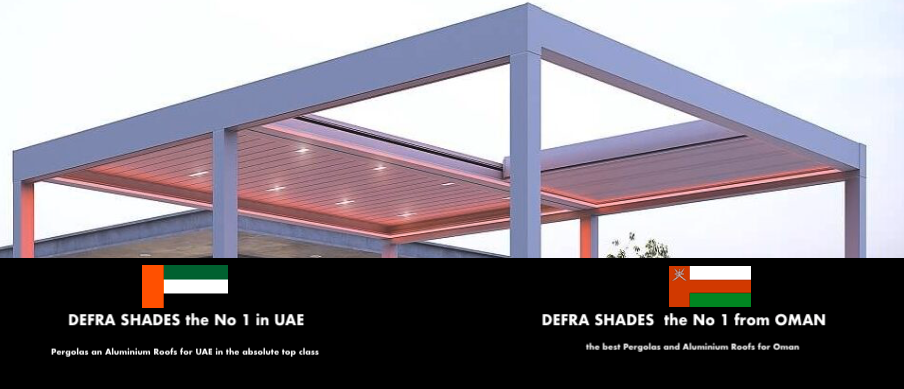
Installing a pergola awning is an effective way to create an inviting outdoor atmosphere while providing necessary protection from the elements. It is important to select the right shade for your needs, as well as consider other factors such as location and weather patterns. Proper installation of a pergola awning ensures that it is functional, aesthetic, and secure.
When selecting the best shade for your pergola awning, there are several options to choose from. Sunbrella fabric offers excellent protection from UV rays and helps keep temperatures cool in hot climates. Other materials like aluminum or wood can provide additional privacy or decorative elements depending on what’s desired for the space. Additionally, take into consideration the location of where you will be placing the pergola; this will help determine which materials are most appropriate based on weather patterns in that area.
Once you have made your selection, it’s time to set up your new pergola awning! For those who prefer to do it themselves, there are some installation tips to follow in order to ensure that it remains safe and secure.
To begin with, use quality hardware when attaching mounting brackets and other components so they can withstand strong winds or rainstorms without breaking down over time. It may also be helpful to enlist professional help if needed; this ensures that all parts are correctly installed according to manufacturer specifications and local building codes.
Finally, make sure everything is level before securing each piece together; an uneven frame could result in structural issues down the road. After assembling all parts properly using quality tools such as drills and screwdrivers, perform one final check before enjoying your new outdoor oasis!
With proper planning and careful installation of a pergola awning, you can now enjoy shelter and comfort outdoors any time of year without worry or hassle. With its attractive appearance and reliable protection from both sun exposure and inclement weather conditions alike, it’s no wonder why these protective structures continue to stand out amongst homeowners everywhere looking for ways to enhance their outdoor spaces.
Moving forward with regular maintenance of your newly installed structure will help ensure its longevity so everyone can reap its benefits for years ahead!
Maintenance of a Pergola Awning

Proper maintenance of a pergola awning is essential for ensuring its longevity and ability to provide maximum protection from the elements year-round in an incredibly dramatic fashion. Homeowners who invest in this architectural feature should consider preventative care and regular cleaning tips to keep their investments looking great both inside and out.
Here are some tips on how to maintain your pergola awning:
- Clean regularly – Dirt, dust, and debris can build up over time on the surface of your awning, affecting its look and making it less effective at protecting you from the sun or rain. To avoid this, use a mild detergent soap solution with lukewarm water to thoroughly clean the fabric once every couple of weeks or so.
- Check for tears – Inspect the fabric periodically for any signs of wear or tear such as fraying edges or ripped seams. If you catch these problems early enough, they can be easily repaired before they become larger issues.
- Protect from harsh weather – Excessive heat or cold can cause damage to the material if it isn’t properly protected. Try using window coverings during extreme temperatures to shield the fabric from direct sunlight or severe cold winds that could cause cracking and fading over time.
- Be mindful when retracting – When retracting your pergola awning, make sure not to tug too hard as this could potentially rip or tear holes in the fabric over time due to excessive strain on certain areas. Take care when handling your retractable system and be sure to follow all manufacturer instructions closely for safe operation every time you use it!
Keeping these helpful tips in mind will ensure that you get years of enjoyment out of your pergola awning while also keeping it looking great year-round! With proper care and attention paid towards preventative maintenance, homeowners can rest assured that their investment will continue providing comfort and shelter no matter what Mother Nature throws at them. In addition, investing in quality materials upfront will help reduce future costs associated with repair work down the line due to wear and tear caused by poor upkeep habits.
Cost of a Pergola Awning

The cost of a pergola awning can vary significantly depending on the size and complexity of the structure. Budgeting for construction costs should be taken into consideration when deciding to install a pergola awning.
Factors such as materials, labor, and any necessary repairs or alterations must be factored in when calculating the total cost. Additionally, any additional accessories such as hardware or lighting fixtures might also need to be included in the budget.
When building a pergola awning, it is important to consider how much money will be needed upfront to cover all of these expenses. It may be beneficial to shop around for prices so that all necessary items can be purchased at the best possible price. Purchasing quality materials that are built to last may end up being more economical in the long run, even if they require an initial higher investment.
In addition to material costs, there are other expenses associated with installing a pergola awning such as hiring professional contractors or electricians if needed. When looking for contractors, it is important to get quotes from multiple companies so that you can compare their services and choose an option that fits within your budget while still ensuring quality workmanship.
It is essential when planning for a new project like this one that potential costs are accurately calculated before beginning construction on the pergola awning. By taking time beforehand to ensure everything is accounted for financially and making sure all materials are of good quality will help make sure everything runs smoothly upon completion without going over budget.
With careful preparation and budgeting, having shelter and comfort with an outdoor living space like this one can easily become reality without breaking bank accounts.
Conclusion
Research shows that on average, the cost of installing a pergola awning can range from hundreds to thousands of dollars depending on the size and complexity of the structure. Despite the potential financial investment, many people find that adding an awning to their outdoor space provides endless relaxation benefits as well as valuable protection from harsh weather conditions.
The added shade and shelter created by the awning helps make any outdoor area more inviting and comfortable for family gatherings, parties or just relaxing in solitude. A pergola awning adds charm to any backyard setting while providing shelter from sun and rain alike. Its stylish design allows you to enjoy your outdoor living space without having to worry about wind or showers interrupting your enjoyment. This makes it easy to entertain guests or simply relax with your favorite book undisturbed by inclement weather.
Additionally, you’ll have peace of mind knowing that you are less likely to be exposed to dangerous ultraviolet rays due to being shaded under an awning during sunny days. In addition, some homeowners find they can even save money over time when they install an awning because it reduces energy costs associated with cooling down their home during hot summer months when direct sunlight enters through unprotected windows and doors.
A well-made pergola also requires minimal maintenance, making it an ideal choice for those who don’t want frequent upkeep but still desire reliable weather protection from their outdoor living area. Installing a pergola awning is one way people can make their outdoor environment inviting while offering much needed protection against harsh weather elements all year round. With its multiple advantages, this type of installation offers considerable value in terms of comfort, cost savings and style for anyone looking for shelter and relaxation in their own backyard oasis.
Frequently Asked Questions
What is the expected lifespan of a pergola awning?
The expected lifespan of a pergola awning depends largely on the type of weatherproofing used, as well as the amount of maintenance it receives. Generally, if properly cared for with regular cleaning and treatment with waterproof sealants, most pergola awnings can last between five and fifteen years.
Additionally, many manufacturers offer warranties that cover parts such as fabric and frames to extend the life even further.
It is important to note, however, that the longevity of any pergola awning will be greatly affected by its environment and use.
Does the cost of a pergola awning depend on the type of material used?
The cost of a pergola awning can vary significantly depending on the type of material used. Factors such as quality, size, and ease of installation will all impact the overall price.
Quality materials such as aluminum or vinyl offer superior durability and are more expensive than wood or other less expensive materials. Installation is also an important factor to consider when budgeting for a new pergola awning, as professional installation may be required for some materials and sizes.
Understanding the cost factors involved in purchasing a pergola awning can help ensure you make the best decision for your needs while still staying within budget.
Is a professional required to install a pergola awning?
Choosing and installing a pergola awning can be a complex decision, as there is no one-size-fits-all solution. Professional installation is recommended to ensure that the structure meets local building codes and is properly fitted for your home or business.
When selecting an installation professional, look for someone experienced in the type of pergola you are interested in purchasing, and make sure they have all necessary permits to install the awning.
Additionally, it’s important to research maintenance tips prior to purchase so you know how to care for your new addition.
With careful consideration and proper maintenance, a pergola awning can provide years of shelter and comfort.
Are there any special considerations for installing a pergola awning in a windy area?
When installing a pergola awning in a windy area, one should take special considerations into account due to the potential for increased structural strain. According to recent research, winds exceeding 30 mph can cause significant damage to outdoor structures that are not designed with sturdy materials and durable construction.
Therefore, when selecting a pergola awning for installation in windy areas, it is important to choose models that have been tested and certified for greater resistance against high winds. Furthermore, extra care should be taken during installation by following manufacturer instructions and ensuring all components are properly secured.
With proper planning and consideration of the environment, homeowners can ensure their new pergola awning provides shelter and comfort no matter how windy it may get.
Are there any local regulations or building codes that must be adhered to when installing a pergola awning?
When installing a pergola awning, it is important to consider any local regulations or building codes that must be adhered to. Depending on the location, permits may be needed in order to install a pergola awning legally and safely.
It is also important to consider any safety issues associated with installation; such as making sure it is securely fastened and reinforced for windy areas in order to ensure its longevity and prevent damage or injury from occurring.
Conclusion
The installation of a pergola awning is an excellent way to add shelter and comfort to any outdoor living space. Not only will it provide protection from the elements, but it also adds style and value to a home or business. With dozens of materials available, there is something for every taste and budget.
Furthermore, the cost of installing a pergola awning can range from $1500-$3000 depending on size and material used. On average, homeowners can expect to save up to 40% in energy costs when they install a pergola awning. With proper maintenance, this investment will continue providing years of satisfaction.
In conclusion, by investing in a pergola awning, homeowners are able to enjoy their outdoor spaces without worrying about inclement weather or high energy bills all year round.
